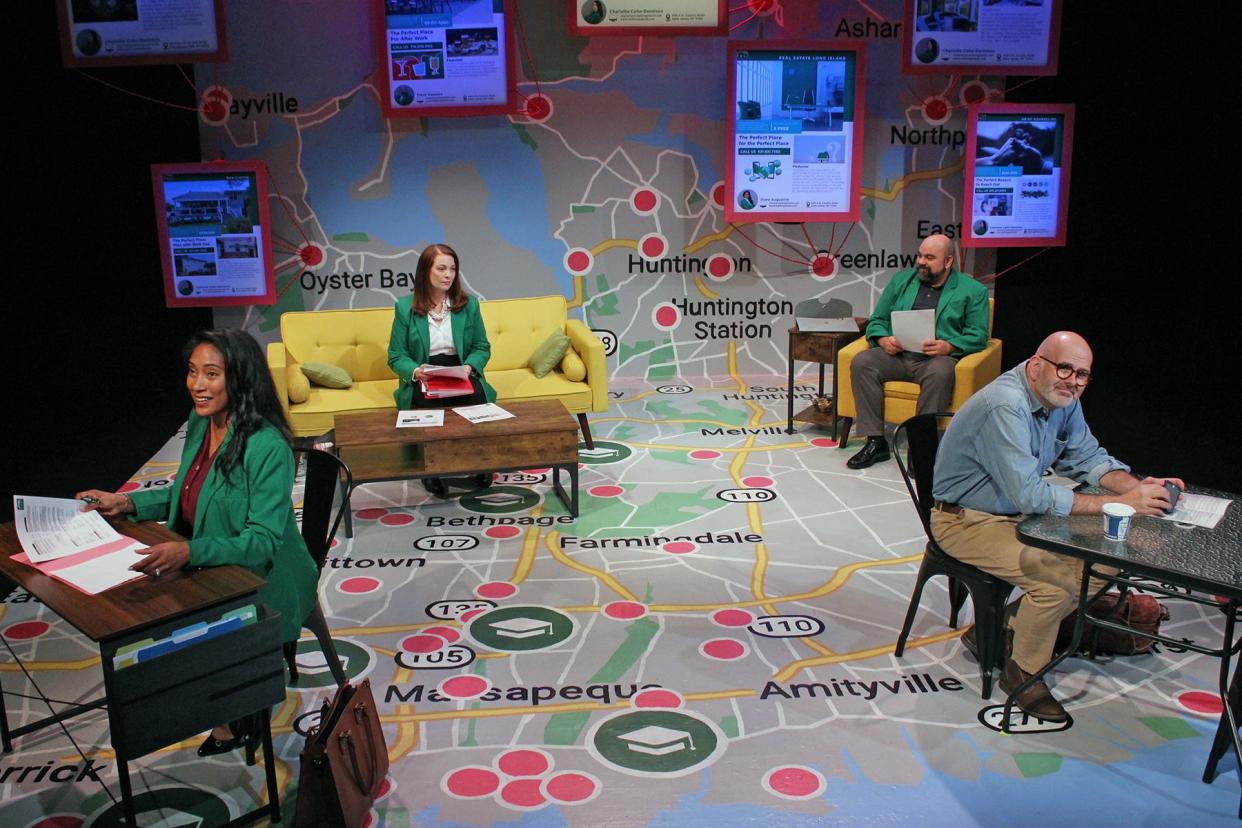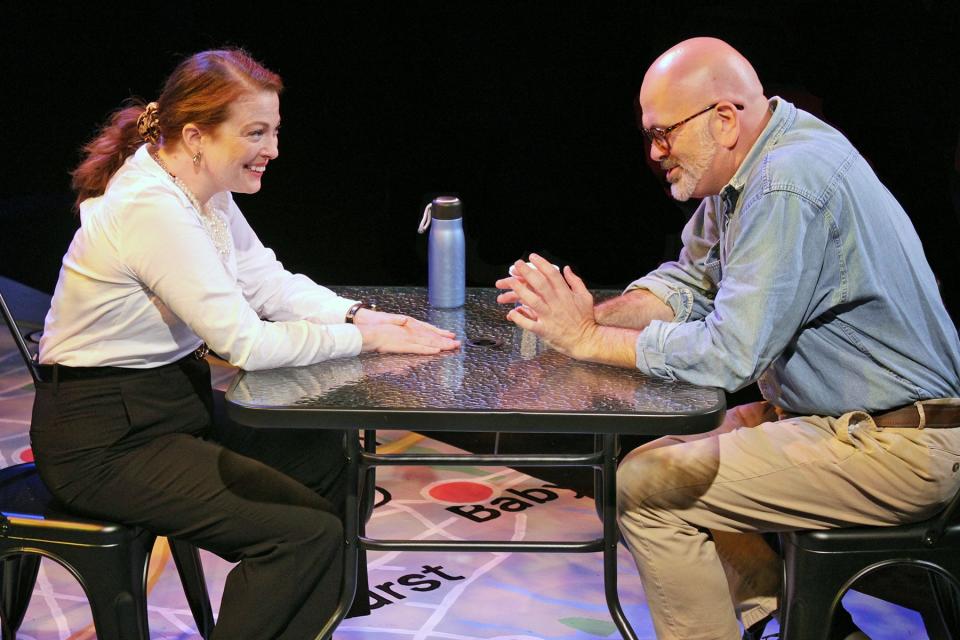From concept to curtain: How Williamston Theatre pros collaborated for 'On the Market'

WILLIAMSTON — Four actors stand on stage at the conclusion of Williamston Theatre's "On the Market," graciously accepting the audience's applause.
They are the faces of the romantic comedy that runs through Oct. 22.
But it's the behind-the-scenes work that brings any finished product to the stage. Producing live theater takes collaboration, solitary thought, tough decision-making and lots of experience.
And it takes time.
In the case of "On the Market," here's how the process unfolded:
In mid-July, 14 weeks before "On the Market" opened, Tony Caselli, director and co-founder of the theater, held his first production meeting. Alongside him was Kirk Domer, set designer and professor of theater at Michigan State University. He has worked with Williamston Theatre for years.
“The leadership team and founders of the theater work wonderfully together," Domer said. "Tony Caselli, John Lepard, Emily Sutton-Smith and Chris Purchis have been there from the beginning (17 years) and if any one of them would leave, it wouldn’t be the same. They are a true team.”
The people at that first meeting in July included Caselli, Domer, Eric Van Tassell (lights), Karen Kangas-Preston (costumes), Michelle Raymond (properties and set dressing), Bran Cole (sound), Stefanie Din (stage manager), and Aaron Delnay (technical director). They are all paid professionals.
For some plays, they may also use a choreographer, musical director, intimacy director, projections (media) designer, producer, cultural consultant and flight director.
Caselli told them about his interpretation of what the play was trying to accomplish and how he wanted to create it.
“That first meeting sets the stage for the entire process," Caselli said. "The team must hear the message and get it into their heads.”
Caselli discussed the potential challenges, what the set could look like and the general feel of the play.
“This play has 17 scenes in seven different locations. How do we create all these locations? How do we change the set and scenery?" he asked. "We have a very small stage at Williamston, and we are always looking for the fastest and easiest way of working with the space.”
The team met again two weeks later, armed with ideas and initial designs.
Williamston Theatre does a lot of new plays, creating the shows for the very first time. If it's an established play, Caselli will do some research: “I’ll go back and see how other theater companies solved the problems. I’ll read reviews and see where productions failed the most or fell flat.
“But the most important information comes from my own design team," he said. "As you read the play, you get a sense as to what it should look like and feel like. I love what we do. Everyone has different viewpoints on life and everyone will have different reactions to the play.”
After the initial meeting, Domer went back to his office to create a 3D rendering of the set using a computer-aided design program. He is head of set design at MSU and has been there for 22 years. He’s designed shows for operas, comedies, musicals, and dramas in professional theaters throughout the country. He’s confident about what he does.
“I loved theater and singing in high school, but I also loved tools and tinkering from working at (my father's) hardware store," said Domer, who grew up in Orville, Ohio. "Being a set designer does it all for me.”
Domer sees the process of preparing a play as a wheel. The director is at the hub, and all the designers and actors surround him like spokes.
The team got down to brass tacks in the second meeting; that’s when the options were presented and decisions were made.
“Our goal is not to argue our individual concepts," Domer said. "We collaborate. So, I present three design options for Tony, and he chooses.”
“Usually there’s a great deepening about what the play is about,” Caselli said. “We always talk about what we want the story to tell. Then we bounce all decisions against the wall.”
Domer said, “We don’t spend a lot on the set. We beg and borrow materials from everywhere. I bet we average about $2,000 per show.”
“I’d rather spend my money on people (actors and designers), not scenery and costumes. That’s what’s important,” Caselli said.
An important consideration in Domer’s set design is how the action flows throughout the play. So, although few theater-goers realize it, the set designer contributes a great deal to the blocking of the play. That movement dictates main elements of the set.
The director's job is to listen to everyone’s thoughts and start to fine-tune the overall ideas.
“You don’t have to own every idea yourself," Caselli said. "But it’s your responsibility to pick and choose. You must make a choice. Everything that happens on that stage from the opening to the curtain call is the result of a director saying yes or no. If he is wishy-washy about making decisions, the play will suffer.“
By the fourth production meeting, everyone knows what the design will look like, how much it will cost and the deadlines. The technical director, a full-time position at Williamston Theatre, is in charge of building the set.

For Caselli, the peak of collaboration is when the actors join the designers and director.
”We have three main groups that we must advocate for: the playwright, the audience and the story itself," he said. "But after I and all the designers leave, it’s the actors who throw themselves out there every night.”
The actors begin their work five weeks before the play opens. They rehearse for three weeks with a tech weekend, and then there are four rehearsals and preview performances.
"These preview performances are very important" Caselli said. "We give (corrective) notes to the actors after every show and we learn from the audiences who attend the shows. Their comments mean a lot. Week 5 is when we have extra rehearsals and polish things up.”
Changes in the show can take place only before the show officially opens. By equity (actors union) rules, once the show opens, the show doesn’t change. The stage manager, who is on site for most every show, will provide “maintenance” and talk to actors if things are not as sharp as they should be.
When the play's run finally begins, the work of most of the production team is over. Some aren't even in town when the show runs.
After "On the Market" closes Oct. 22, the set will be dismantled and the stage will be cleared, making way for a new team of designers, actors and a director deep into the finishing touches of another play.
And so it goes.
This article originally appeared on Lansing State Journal: How Williamston Theatre pros collaborated for 'On the Market'

